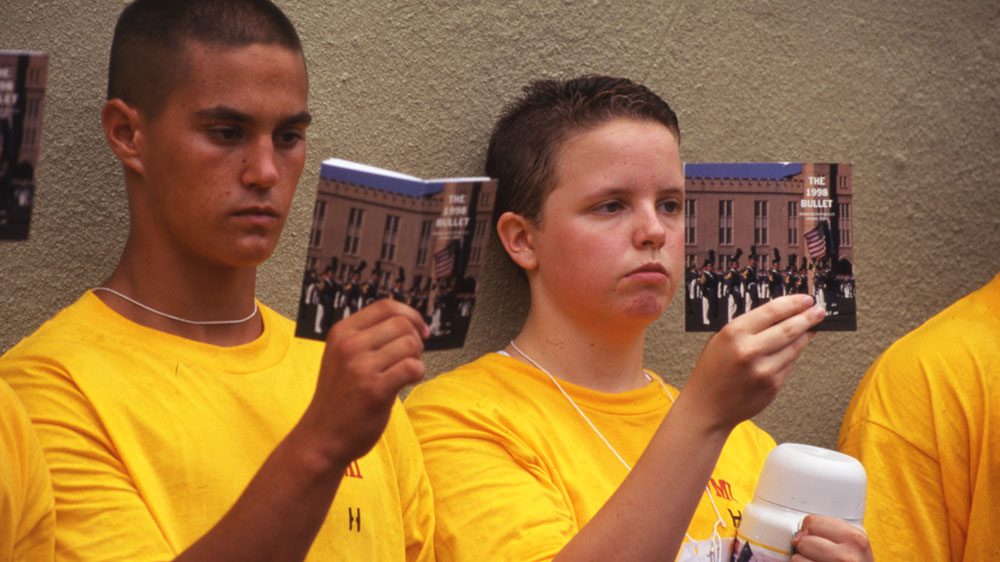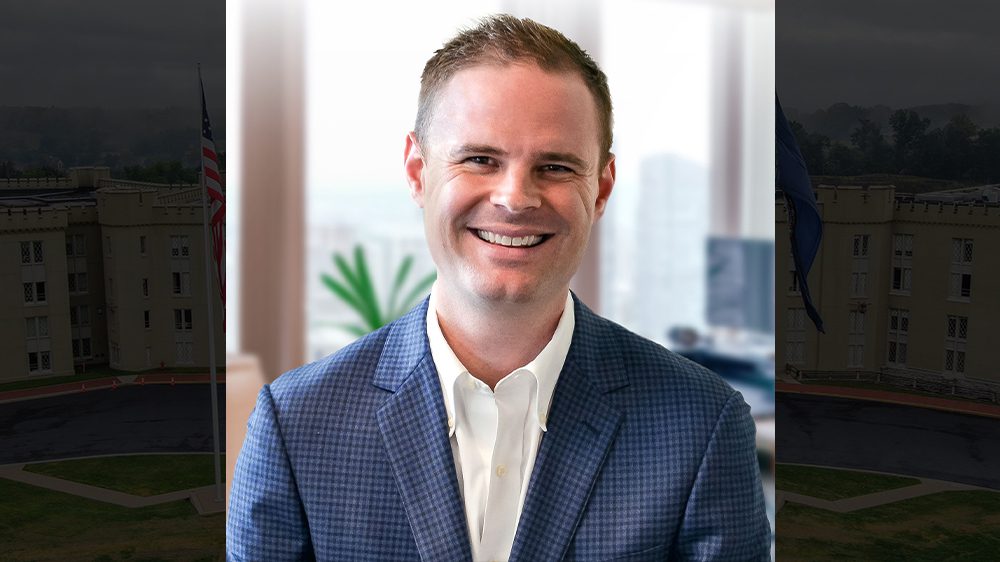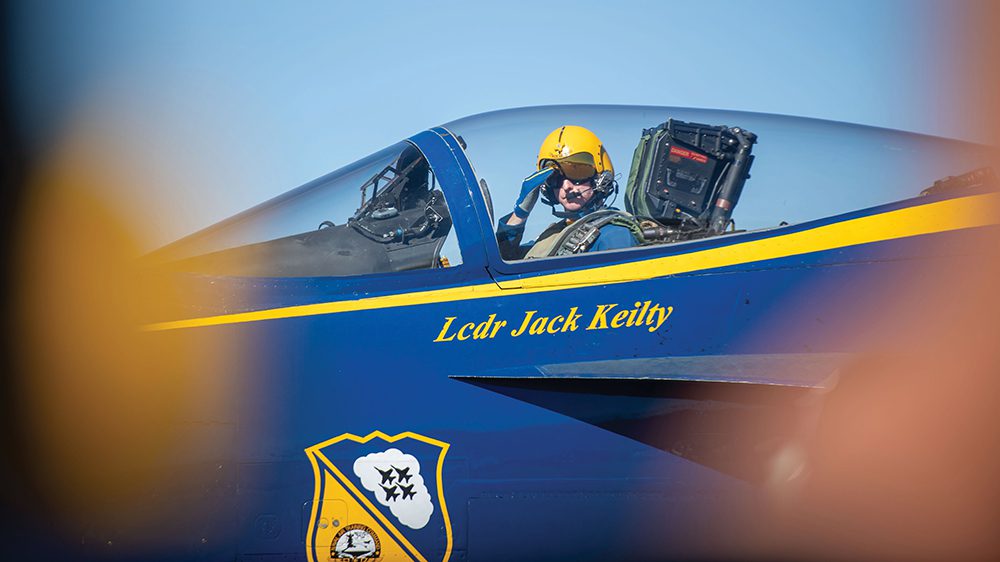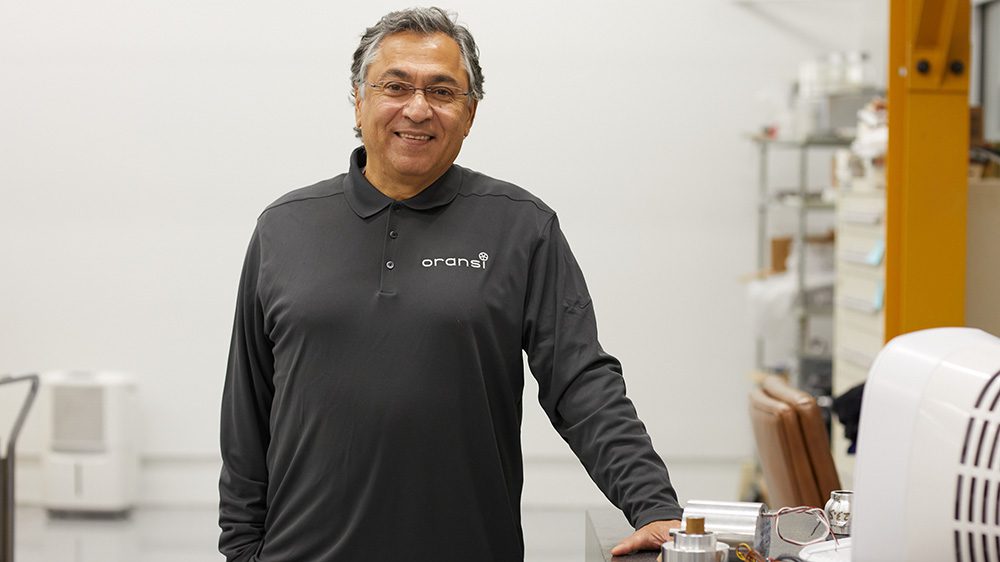Editor’s Note: The VMI Alumni Agencies shared the video above during the 25th anniversary celebration dinner Sept. 9, 2022.
Months of planning culminated in the celebration of 25 years of women at VMI Sept. 8-10. Click to review a recap of the weekend, photos, as well as a historical look-back at what it was like on post in 1997.
The Weekend’s Events | Photos from the Weekend | “A High Mountain to Climb”
The Weekend’s Events
With solidarity and pride in their accomplishments, more than 214 alumnae and their families returned to Lexington Sept. 8-10 to celebrate a milestone in Institute history: 25 years since the first women matriculated at VMI in August 1997. In the quarter century that has passed since that historic moment, the Institute has marked several “firsts” by VMI women, most recently with Kasey Meredith ’22 becoming VMI’s first female regimental commander.
The 25th anniversary celebration of women at VMI was organized by the VMI Alumni Agencies to celebrate the myriad accomplishments of alumnae and offer them a chance to network both with each other and current female cadets.
Events began Thursday, Sept. 8, with an early arrivals reception held that evening in the Pogue Auditorium in the George C. Marshall Research Library. The next morning, the event kicked off with a welcome session in Gillis Theater in Marshall Hall, where David Prasnicki, Alumni Agencies chief operating officer, introduced Maj. Gen. Cedric T. Wins ’85, superintendent.
“You did not give up, and you have made a profound impact on the Institute,” Wins noted. He then mentioned the accomplishments of several alumnae, among them U.S. Army Col. Angelica Martinez ’02, chief of strategic plans for the U.S. Security Coordinator for Israel and the Palestinian Authority; U.S. Navy Cmdr. Bree Adams Gutterman ’04, proprietor of a property management business and a member of the VMI Foundation Board of Trustees; and Lezshell “Shelly” Pauling ’06, a mental performance coach now working with U.S. Special Operations Command soldiers.
The women in barracks today “are building on the foundation you set,” Wins told his audience. “VMI is, by every measure, a better place with women in the Corps.”
Next up was a panel called Generations of Women at VMI, featuring 10 alumnae from a wide spectrum of classes. Their time was spent discussing how VMI had forged and formed them, what advice they had for current female cadets, and how VMI can learn from the integration of women into the Corps of Cadets.
Many shared that VMI had prepared them for uncertainty and change; more than one expressed the sentiment, “When you get out of VMI, you are going to be a rat.” The transition from higher education to the workplace was easier for them than for others, they stated, because they’d already learned that being in new and uncomfortable situations is often necessary for growth.
Following the Generations of Women at VMI panel, another panel focused on entrepreneurship among VMI women. Five alumnae, including a chef, a fashion designer, and an attorney, among others, discussed their journeys to self-employment, and they did not hold back in sharing the highs and lows of being their own bosses.
“I’m not the sharpest tool in the shed. I just had to work really hard,” said Lara Tyler Chambers ’03, a land developer and vice chair of the VMI Board of Visitors.
Elise Woodworth ’07, who runs an executive coaching business, Woodworth Enterprises LLC, said that VMI prepared her for entrepreneurship by giving her lots of chances to test her skills in a variety of areas. “At VMI, there are so many opportunities to experience diverse things,” said Woodworth. In terms of choosing a path to self-employment, “Look at what your passion is and what brings you happiness,” she stated.
Woodworth told her listeners that she recently finished writing a book, Business Before Battle, and balanced that responsibility with homeschooling her five children. “Don’t ever give up,” she advised.
Following a networking lunch in Crozet Hall, two more panel sessions followed, one focused on women in STEM and the other on careers in the military and as first responders.
That evening, alumnae, alumni, and current cadets came together for a celebratory dinner, held in the Hall of Valor in Marshall Hall. An Alumni Agencies-produced video highlighted the painstaking preparations for the first women’s arrival in 1997, as well as the extensive nationwide news coverage of their first days on post.
The evening’s speaker, Virginia National Guard Maj. Gen. Marti J. Bissell, deputy commanding general, discussed her four-decade-long relationship with VMI and how she’d seen the Institute evolve over time.
With warmth and humor, Bissell described how she’d grown up with little exposure to the military and then became a member of the VMI family. Her first visits to VMI were in the 1980s with her husband, Col. Gary Bissell ’89, VMI deputy chief of staff and operations, and at the same time, she was getting to know her father-in-law, retired U. S. Army Brig. Gen. Norman M. “Mike” Bissell ’61. The elder Bissell, now deceased, served as VMI’s first non-active-duty commandant of cadets from 1990–94.
Eventually, Bissell came to work for the Institute herself, serving in a variety of teaching and administrative positions. From her front-row seat, Bissell saw the Institute change as society was changing.
“VMI does change, is constantly changing, and will continue to change,” she declared. Examples of change prior to the integration of women included the introduction of indoor plumbing and a switch from sacks stuffed with hay to mattresses, she observed, among many others.
On Saturday, alumnae were guests of honor at the morning’s parade, and in the afternoon, rain did not dampen the spirits of the women and their families as they were honored at halftime of VMI’s football opener against Bucknell University, a matchup that ended with a 24-14 Keydet victory.
“A High Mountain to Climb”
In late June 1996, six years after the U.S. Department of Justice filed a lawsuit challenging VMI’s single-sex admissions policy, the U.S. Supreme Court issued a 7-1 decision requiring the Institute to admit women. While the VMI Board of Visitors still had to decide if the Institute would accept the court’s ruling—or pursue privatization—immediately after the court decision, Maj. Gen. Josiah Bunting III ’63, then-superintendent, directed the Institute’s staff to begin preparing for the admission of women.
The BOV voted on how VMI would respond to the Supreme Court’s decision on its single-sex admissions policy Sept. 21, 1996. By a vote of 9-8, the board accepted the decision and announced VMI would admit women in August 1997.
The timing of the BOV’s vote meant the Institute would not admit women in August 1996 (when The Citadel first admitted women), providing time in which VMI could consult with other institutions that had already integrated women, thoroughly examine the structure of cadet life as well as the Institute’s facilities, and then make the changes necessary to integrate women successfully.
In retrospect, this was a blessing, as the task ahead of VMI was nothing less than a thorough transformation. This scope and variety of the tasks at hand are reflected in the fact that VMI established seven committees—such as recruiting, facilities, and athletics—and assigned dozens of faculty, staff, and cadets to serve on them to drive evaluation, planning, and execution.
The objectives were varied, but the critical focus was to conserve the core elements of the cadet experience: The Honor Code, the Rat Line, and barracks life. As Bunting said in a recent interview, the thinking was, “We owe it to entering cadets, whether male or female, to preserve the best elements unchanged, but to do it properly, in a way that brings credit to VMI.”
One of the first things VMI did was send faculty, cadets, staff, and administrators to visit colleges that had admitted women to a previously all-male student body. Among the schools VMI representatives visited were the federal service academies, including the U.S. Merchant Marine Academy; New Mexico Military Institute (a junior college); Norwich University; and Texas A&M University. It also contacted its next-door neighbor, Washington & Lee University, which had become co-ed in the mid-1980s. The Institute learned much from these visits and was so impressed by the example that Bunting created an exchange program with Norwich and Texas A&M to ensure that some experienced female cadets would be present in barracks when women arrived. It also would offer two-year scholarships to male and female graduates of New Mexico Military Institute. “Reaching out to other schools [that] had preceded us in this effort was a stroke of genius,” said Col. Keith Gibson ’77, VMI Museum System executive director. “I do not think any other college had previously done that. I recall General Bunting using the metaphor of a mine field. If we wished to get across safely, we should talk to those who had already traversed the field in order to identify the mines and learn how to avoid them.”
Orchestrating this effort, including coordinating the work of the committees, was the job of Col. N. Michael Bissell ’61. Bissell had returned to VMI in 1990 to serve as its first full-time commandant of cadets. In 1994, he became a special assistant to the superintendent. People on and off post admired Bissell’s ability to balance competing demands for attention while using his considerable powers of persuasion to assuage any doubts about the potential for success.
It is an understatement to say that there were many things to do to prepare the Institute for Matriculation Day 1997. As Carole Green, who Bissell hired as his assistant and would later be VMI’s deputy Title IX officer, recalled, “We went over everything that went on at VMI. We talked to faculty, staff, and cadets. We looked at everything in barracks, everything in the academic buildings, to be able to assess what really needed to be changed and what didn’t because we wanted to maintain as much of the character [of VMI] as possible.”
And, by “everything” at VMI, Green was entirely accurate. For example, there was VMI’s lexicon—words like “brother rat.” Should male cadets and female cadets be addressed respectively as “Mister Smith” and “Miss Smith” or as “Cadet Smith?” VMI examined and evaluated the need to introduce new uniforms and adjust current ones. Eventually, VMI authorized a skirt for female cadets but then had to settle on the style and color of stockings to accompany it. Other discussions concerned what types of jewelry and cosmetics women could wear to ensure an experience like male cadets.
The Institute spent a lot of time on what might seem a small matter: Haircuts. The initial question was whether female rats would receive the same short haircut their male counterparts would receive. Some asserted that if the women wanted the VMI experience, it should include the rat haircut, while others counseled that too severe a haircut would seem punitive. In the end, the leaders decided to apply the same standard but later allowed female rats to have longer hair.
Much the same discussion existed concerning VMI’s physical fitness standards. Some asserted the physiological differences between men and women dictated that VMI apply different standards for the required VMI Fitness Test for each sex. Others opposed different standards, warning that doing so might dilute the experience of the female cadets.
One member of VMI’s staff particularly opposed to the establishment of different physical standards was Green. Determined to prove that women could meet the standards, she began weight training in VMI’s weight room. Working out three days a week, her pull-up counts steadily rose, and soon she was able to do three sets of 25 push-ups a day. By the time the first women matriculated, Green—who was then in her 50s—was able to do 10 pull-ups, and in spring 1998, she “maxed out” on the pull-ups, doing 20 at a time. In the end, VMI decided to apply the same standard for the VFT to both men and women.
“[T]hey knew everybody was watching them. And they were terrific. They were great. They were determined to prove themselves, and they did.”
Maj. Gen. Josiah Bunting III ’63, VMI's 13th superintendent
Another major change in VMI’s programs also was the introduction of NCAA women’s sports. Taking the lead on this was Brig. Gen. Mike Bozeman, who had been coaching track and field since 1986 and who also had served as the commandant for two years. He established a women’s cross-country team almost immediately and recruited other women for track and field events.
As Green alluded, every building on post was assessed to support a transition. New facilities were added in Cocke Hall, Cameron Hall, and “The Pit,” as well as the academic buildings and Crozet Hall. VMI developed a security lighting plan after months of careful study and advice from law enforcement.
Another issue was where female cadets would live. VMI considered options that included a separate wing of barracks and renovating an existing building. In the end, Bunting’s declaration that the essence of the cadet experience must be preserved made the answer obvious. The Corps of Cadets lives in the barracks, and as women were to be cadets in every sense of the word and must develop close bonds with their male classmates, they must have the opportunity to live in barracks.
It is important to note that as VMI did all this, it was scrutinized by the federal government (one inquiry from the U.S. Department of Justice contained more than 50 questions), state government, outside groups, and the news media.
The Institute did everything in its power to turn this attention to its own benefit. One instance of that was the convocation at Cameron Hall March 11, 1997. Open to the press and the public and attended by all faculty, staff, and cadets, Charles F. Bryan Jr. ’69, then-director of the Virginia Historical Society, delivered the keynote address. Bryan started by pointing out that, throughout its history, VMI was characterized by its “ability to change and to adapt when it had to or was forced to.” The Institute, he said, was “an ever-changing institution.” He listed five events that had fundamentally changed VMI, such as racial integration, and pointed out how traditions, like the dyke system, had evolved. He called upon cadets to take the admission of women as “an opportunity to show the world … we can make this profound, and change in an effective and meaningful way to do all in our power to make VMI even a better place.”
Looking back at the intense activity during the 14 months between the Supreme Court decision and the day the Class of 2001 matriculated, Bunting said, “It was a huge mountain to climb. But one of the great things about the American military culture, especially in a place like VMI is … the decision having been reached, your mission is to make sure that that decision … takes hold properly and enlist the support of everybody who are going to be its beneficiaries.”
Among those enlisted in the effort were the Corps of Cadets. Along with their service on committees, every cadet—and every employee—received extensive training on what policies would be on a wide range of issues to include fraternization, down to the company level. Still, many cadets remained opposed to the concept of a co-ed VMI and were frank in their animosity. The fact remains, however, that cadets came to embrace the fact that women were now part of the Corps.
Green credited much of this attitude to the cadets themselves, especially the leadership of the Class of 1998, such as Kevin Trujillo ’98, class president; Timothy Trant II ’98, regimental commander; and Jon Spitzer ’98, RDC president. “I was really impressed with how professional the cadets were,” Green recalled recently. “It goes back to the Corps taking action to run the business within the Corps.” She continued, “The Class of 1998’s leadership deserves a great deal of credit for getting that first group of women through their first year. They took such good care of them.”
Within the ranks of alumni, perspectives shifted as more women matriculated and graduated. In fact, Lara Tyler Chambers ’03, currently a vice president of the Board of Visitors, recounts how her father, Webb L. Tyler ’73, contributed to the cause of keeping VMI all-male; however, once the decision was made to admit women, he encouraged her to attend. “It’s a good school,” she recalls him saying. “You are allowed to go—might as well go.” Chambers, who majored in civil engineering and is now the co-owner of the Tyler Development Group, a land development company in Mechanicsville, Virginia, said of her experience, “It teaches you how accomplish things you didn’t think you could accomplish.”
Of the young women who entered VMI Aug. 18, 1997, Bunting said, “[T]hey knew everybody was watching them. And they were terrific. They were great. They were determined to prove themselves, and they did.”
Bunting remembers the graduation of the Class of 2001 as “a great moment of triumph and vindication and great pride.” And, when asked how he felt when he saw Cadet Kasey Meredith ’22, VMI’s first female regimental commander on the cover of the VMI Alumni Review, he said the position of first captain is “somebody who represented perhaps above everyone else the qualities that VMI stands for. In her being selected, this represents VMI at its best; I could not be prouder.”
Since August 1997, hundreds of women have accepted the challenges of being a VMI cadet. As with any VMI graduate, they have enjoyed success in various career fields and served the country and their communities. Theirs have been lives of purpose and honor, and they have brought great honor to the Institute.
The next several pages contain profiles of some of the Institute’s earliest alumnae and those who have come after them in the past 25 years. Each woman has a unique story to tell, but everyone who has signed the Matriculation Book will see reflections of their own experiences in these accounts. And that’s only fitting because, first and foremost, these are VMI stories.
-

Scott Belliveau '83 Communications Officer - Executive Projects
The communications officer supports the strategy for all communications, including web content, public relations messages and collateral pieces in order to articulate and promote the mission of the VMI Alumni Agencies and promote philanthropy among varied constituencies.

Christian Heilman Director of Digital Content
The director of digital content is responsible for creating original video and multimedia materials, as well as developing and editing web and digital content. The director is responsible for platform coordination and troubleshooting, to include the VMI Alumni Agencies’ primary websites, digital newsletter and other digital platforms.

Mary Price Development Writer/Communications Specialist
The development writer plays a key role in producing advancement communications. This role imagines, creates, and produces a variety of written communication to inspire donors to make gifts benefiting VMI. Utilizing journalistic features and storytelling, the development writer will produce content for areas such as Annual Giving, stewardship, and gift planning.





